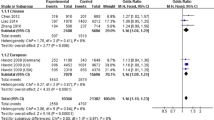Abstract
PICALM gene rs3851179 polymorphism was reported to an Alzheimer’s disease (AD) susceptibility locus in a Caucasian population. However, recent studies reported consistent and inconsistent results in an Asian population. Four studies indicated no association between rs3851179 and AD in a Chinese population and one study reported weak association in a Japanese population. We consider that the failure to replicate the significant association between rs3851179 and AD may be caused by at least two reasons. The first reason may be the genetic heterogeneity in AD among different populations, and the second may be the relatively small sample size compared with large-scale GWAS in Caucasian ancestry. In order to confirm this view, in this research, we first evaluated the genetic heterogeneity of rs3851179 polymorphism in Caucasian and Asian populations. We then investigated rs3851179 polymorphism in an Asian population by a pooled analysis method and a meta-analysis method. We did not observe significant genetic heterogeneity of rs3851179 in the Caucasian and Asian populations. Our results indicate that rs3851179 polymorphism is significantly associated with AD in the Asian population by both pooled analysis and meta-analysis methods. We believe that our findings will be very useful for future genetic studies in AD.

Similar content being viewed by others
References
Bertram, L., McQueen, M. B., Mullin, K., Blacker, D., & Tanzi, R. E. (2007). Systematic meta-analyses of Alzheimer disease genetic association studies: The AlzGene database. Nature Genetics, 39(1), 17–23.
Chen, L. H., Kao, P. Y., Fan, Y. H., Ho, D. T., Chan, C. S., Yik, P. Y., et al. (2012). Polymorphisms of CR1, CLU and PICALM confer susceptibility of Alzheimer’s disease in a southern Chinese population. Neurobiology of Aging, 33(1), 210 e211–210 e217.
Harold, D., Abraham, R., Hollingworth, P., Sims, R., Gerrish, A., Hamshere, M. L., et al. (2009). Genome-wide association study identifies variants at CLU and PICALM associated with Alzheimer’s disease. Nature Genetics, 41(10), 1088–1093.
Hollingworth, P., Harold, D., Sims, R., Gerrish, A., Lambert, J. C., Carrasquillo, M. M., et al. (2011). Common variants at ABCA7, MS4A6A/MS4A4E, EPHA1, CD33 and CD2AP are associated with Alzheimer’s disease. Nature Genetics, 43(5), 429–435.
Jiang, Y., Zhang, R., Zheng, J., Liu, P., Tang, G., Lv, H., et al. (2012). Meta-analysis of 125 rheumatoid arthritis-related single nucleotide polymorphisms studied in the past two decades. PLoS ONE, 7(12), e51571.
Jun, G., Naj, A. C., Beecham, G. W., Wang, L. S., Buros, J., Gallins, P. J., et al. (2010). Meta-analysis confirms CR1, CLU, and PICALM as Alzheimer disease risk loci and reveals interactions with APOE genotypes. Archives of Neurology, 67(12), 1473–1484.
Lee, J. H., Cheng, R., Barral, S., Reitz, C., Medrano, M., Lantigua, R., et al. (2011). Identification of novel loci for Alzheimer disease and replication of CLU, PICALM, and BIN1 in Caribbean Hispanic individuals. Archives of Neurology, 68(3), 320–328.
Li, H. L., Shi, S. S., Guo, Q. H., Ni, W., Dong, Y., Liu, Y., et al. (2011). PICALM and CR1 variants are not associated with sporadic Alzheimer’s disease in Chinese patients. Journal of Alzheimer’s Disease, 25(1), 111–117.
Liu, G., Zhang, L., Feng, R., Liao, M., Jiang, Y., Chen, Z., et al. (2013). Lack of association between PICALM rs3851179 polymorphism and Alzheimer’s disease in Chinese population and APOEepsilon4-negative subgroup. Neurobiology of Aging, 34(4), 1310 e1319–1310 e1310.
Logue, M. W., Schu, M., Vardarajan, B. N., Buros, J., Green, R. C., Go, R. C., et al. (2011). A comprehensive genetic association study of Alzheimer disease in African Americans. Archives of Neurology, 68(12), 1569–1579.
Naj, A. C., Jun, G., Beecham, G. W., Wang, L. S., Vardarajan, B. N., Buros, J., et al. (2011). Common variants at MS4A4/MS4A6E, CD2AP, CD33 and EPHA1 are associated with late-onset Alzheimer’s disease. Nature Genetics, 43(5), 436–441.
Ohara, T., Ninomiya, T., Hirakawa, Y., Ashikawa, K., Monji, A., Kiyohara, Y., et al. (2012). Association study of susceptibility genes for late-onset Alzheimer’s disease in the Japanese population. Psychiatric Genetics, 22(6), 290–293.
Ruiz, A., Hernandez, I., Ronsende-Roca, M., Gonzalez-Perez, A., Rodriguez-Noriega, E., Ramirez-Lorca, R., et al. (2013). Exploratory analysis of seven Alzheimer’s disease genes: disease progression. Neurobiology of Aging, 34(4), 1310 e1311–1310 e1317.
Seshadri, S., Fitzpatrick, A. L., Ikram, M. A., DeStefano, A. L., Gudnason, V., Boada, M., et al. (2010). Genome-wide analysis of genetic loci associated with Alzheimer disease. JAMA, 303(18), 1832–1840.
Sweet, R. A., Seltman, H., Emanuel, J. E., Lopez, O. L., Becker, J. T., Bis, J. C., et al. (2012). Effect of Alzheimer’s disease risk genes on trajectories of cognitive function in the Cardiovascular Health Study. American Journal of Psychiatry, 169(9), 954–962.
Xiao, Q., Gil, S. C., Yan, P., Wang, Y., Han, S., Gonzales, E., et al. (2012). Role of phosphatidylinositol clathrin assembly lymphoid-myeloid leukemia (PICALM) in intracellular amyloid precursor protein (APP) processing and amyloid plaque pathogenesis. Journal of Biological Chemistry, 287(25), 21279–21289.
Yu, J. T., Song, J. H., Ma, T., Zhang, W., Yu, N. N., Xuan, S. Y., et al. (2011). Genetic association of PICALM polymorphisms with Alzheimer’s disease in Han Chinese. Journal of the Neurological Sciences, 300(1–2), 78–80.
Acknowledgments
This research is supported by grants from the National Nature Science Foundation of China (Grant number 31171219, 81271213, and 31200934) and US-China Biomedical Collaborative Research Program (NSFC Grant number 81261120404) to Keshen Li, and One Hundred Person Project of the Chinese Academy of Sciences (KSCX2-YW-BR-3)
Conflict of interest
The authors reported no biomedical financial interests or potential conflicts of interest.
Author information
Authors and Affiliations
Corresponding authors
Additional information
Guiyou Liu and Shuyan Zhang contributed equally to this work.
Rights and permissions
About this article
Cite this article
Liu, G., Zhang, S., Cai, Z. et al. PICALM Gene rs3851179 Polymorphism Contributes to Alzheimer’s Disease in an Asian Population. Neuromol Med 15, 384–388 (2013). https://doi.org/10.1007/s12017-013-8225-2
Received:
Accepted:
Published:
Issue Date:
DOI: https://doi.org/10.1007/s12017-013-8225-2




